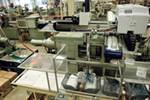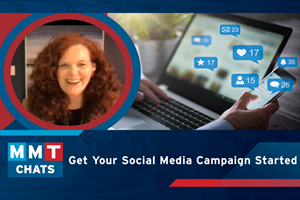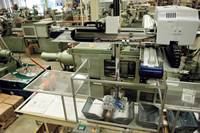Blowing the Competition out of the Water
The members of MoldMaking Technology's Editorial Advisory Board share their thoughts on how American moldmakers can attempt to combat overseas competition.
There are several factors to be considered by the American moldmaker when competing in today's international marketplace; factors that play a key role in where a customer decides to take his business.
What should a moldmaker do to combat foreign competition?
Derek Beattie, owner of Polysurf Mold Design (Galt, CA), a consulting, mold design and solid modeling company. There are both external and internal factors that need to be addressed in order for U.S. moldmakers to compete in today's international marketplace. It is important to know who your competitors are as well as the laws of the arena. Foreign companies are working with their governments in order to compete globally. It is important for U.S. moldmakers to communicate with one another and to become involved with the government as well.
It is imperative that moldmakers be willing to study their competition, learn from them and adapt their business strategy to the changing marketplace. With the information gathered, moldmakers should then be able to analyze their own business in relation to the overall marketplace. There may be areas where they are unable to compete, such as labor costs. What it comes down to is analyzing the operation and formulating a plan that encompasses these critical areas while keeping an eye on the competition and the changing environment. It is important to stay up-to-date with technology and machinery.
Training is another key issue for U.S. moldmakers - it is important to educate tomorrow's toolmakers. Constant scrutiny of production processes and cost analysis also is necessary to maintain a competitive pricing structure.
Walt Bishop, executive director of the Society of the Plastics Industry, Mold-makers Division (Washington, D.C.). In order for a moldmaker to effectively address the issue of foreign competition, it's important to understand the reasons that the customer elected to move his business off-shore. Was it simply for price considerations, speed of delivery, quality of product or perhaps a combination of the three? Once the competitive advantage is clearly understood, the moldmaker can then begin to explore the remedies available to him.
If the issue is price only, the moldmaker could explain to the customer the "hidden costs" that are not apt to appear on any quote. Things like drawing interpretation, dimensional call-outs and pin placements are not easily explained during a trans-Pacific telephone conversation and could very likely result in an unplanned plane ride, as well as in thousands of dollars in travel expenses.
Additionally, the possibility of having the mold delivered in a condition that does not meet the specifications is very real and the potential for emergency repair will certainly add extra dollars to the quoted price.
On the issues of quality or delivery time, the moldmaker has to carefully consider the job being quoted. The tolerances, dimensions, surface finish and other variables affecting the end product must be calculated precisely in order to ensure delivery of the highest quality possible. Having met the challenges of price and quality, the final piece of the puzzle then is delivering the product on or ahead of schedule.
Tom Fenton, toolroom manager for Minntech Corp. (Plymouth, MI), a medical device and solutions manufacturer. How many molds are made outside the U.S. every year? Who is building them? Let's define the threat of the world market. If we can define the threat of foreign competition we can know what we are fighting.
Defining what a shop's goals are is important. If you are producing small molds that China is creating faster, you might want to rethink your business plan and shop floor methods. In addition, moldmakers need to be more united - they need to build strong alliances with other mold shops to help get projects out the door faster.
Joe Genc, engineering coordinator of PM Mold (Shaumburg, IL), a total service toolmaking company that engineers and builds plastic injection molds, compression molds and die cast dies. Moldmakers should offer value added services such as product design, product development, manufacturing development and prototyping. They should become the "last word" in the ability to receive and send data clearly and efficiently.
Take your customers on a video tour of their mold progress; develop the ability to submit a preliminary design via e-mail; develop, promote and practice concurrent manufacturing. Your company's goal should be that high-quality, rapid on-time delivery and competitive price be accomplished simultaneously while maintaining a profit margin. An around-the-clock operation will give you the ability to realistically deliver molds in four to six weeks. Unattended machinery is a must in CNC milling, sinker EDM and wire EDM. Many moldmakers also are becoming molders in order to offer a more complete service package as one source of responsibility.
Jim Koppe, engineering manager for Northwestern Tool and Die (Buffalo Grove, IL), a designer and manufacturer of injection molds. To combat foreign competition, moldmakers need to become as efficient as possible. The machinery is a constant - the labor rate and skill make the difference. Ongoing training is criti-cal to get the most out of machines and programming for CNC. Automatic machines need to be run without operators - one programmer/ setup person should operate as many machines as feasible. The most important step to reducing the operator's labor time is utilizing the best runtime and similar setups. Through this, reductions in labor costs and lead-time should result.
Another area that we must focus on is quality. The accuracy and proper engineering of the tools provides value in the sense of longevity and the buyer must be educated in situations where this is required. It's not only the up-front expenditure, but also the maintenance over the years of poorly built tools and the cost involved of debugging any initial build problems that all become part of the end user's price.
Jean Kroes, owner of J.H. Kroes Consulting (Ottowa, Ontario), a consulting firm specializing in small business matters. Competition, whether foreign or domestic, is a fact of life and needs to be addressed with common sense. First, one has to look at what one has to offer, and then look at what the customer wants. The next step is to get to know your competition, find out what they are offering and if they can beat you out, find out why.
Once you know what the customer wants and what the competition offers, you can turn around and look at how you can meet the challenge. This is the time to find out why the customer has even looked at the competition. Therein lies your first answer to becoming more competitive. Then find out what it would take to keep your customer.
There is no way that you can beat some of the foreign prices. Instead, look at what you can offer - service, delivery, after-sale service and other on-site assistance. If, however, you find out that the customer is going after a new product or standards you don't supply, you will need to go after new clients and create a new market.
Jim Meinert, owner of Snider Mold (Mequon, WI), which builds large compression, injection, RIM and structural foam molds. Competing in the "larger arena" starts with a good awareness of your own strengths and core business advantages, along with an awareness of how you match up against your global competition's strengths and weaknesses. As the margin of error and profit margins decrease, every detail can be a critical success factor. In the past we could compete on the basis of quality, delivery and price, but now we need to focus on four additional factors: differentiation, time compression, adding more value and exports and support for your customers as they go global, possibly with a partner shop in the market near wherever your customer goes.
When we look at things from a global perspective there are many opportunities. The challenge is to be able to recognize them and to find a way to take advantage of them. For example, selling the value of good tooling with more and faster cycles and producing better products is something we have to emphasize constantly. Trends that we must be more involved with are the new software packages that enable companies to go global easier and that are value chain integrators. We must stay in the "loop." Cooperating with neighboring competitors, going to trade shows and trade missions and giving seminars all helps.
David Randal, owner and operator of Randal Welding and Machine (Santa Ana, CA), a specialty tool steel welding house. It's human nature for companies to look for cheaper prices, and the best deal is usually offered offshore. So you have to educate the public. They may get a good looking mold offshore, but will it hold up? Often, we are left with the aftermath of cleaning up the tools. The real concern is the material and the quality control offshore is not there. The greatest advantage of tools made here is that you can walk into a shop and say "stop the presses" and have a design altered immediately.
The best way for American companies to compete with foreign companies is to deliver quality tools and quality service. If we play the game of cheaper price, we will lose. It boils down to good price with good quality in both the workmanship as well as the materials.
Tony Stefanic, owner of Techline Engineering (Alsip, IL), a consulting, product and mold design company. The two main issues in recent times that seem to determine how well a shop competes either locally or globally are the quality of the product and the timeliness of the service. Price has begun to take a backseat to delivery, so the best way to compete globally is to know your competition. We seem to do well when it comes to knowing our local competition but that task is much more difficult when that knowledge has to include a worldwide network of shops competing against you. Becoming more aware internationally of new processes, new techniques and new equipment is always helpful. The bottom line is that the more information you have about your competition, the better prepared you will be to compete with them.
Terry Wohlers, president of Wohlers Associates, Inc. (Fort Collins, CO), an independent consulting firm that works closely with manufacturing organizations to uncover the best approaches to rapid product development. Produce superior products and market them better than the competition. If this occurs, the problem goes away. Be aware of your foreign competitors and know what products they are producing. Gain access to market intelligence and conduct a foreign competitive analysis. Be prepared to spend some money if you want good answers to your questions. Do business in foreign countries and make trips to the countries as often as possible.
Related Content
MMT Chats: Marketing’s Impact on Mold Manufacturing
Kelly Kasner, Director of Sales and Marketing for Michiana Global Mold (MGM) talks about the benefits her marketing and advertising, MGM’s China partnership and the next-generation skills gap. This episode is brought to you by ISCAR with New Ideas for Machining Intelligently.
Read MoreMMT Chats: Impressions and Inspirations from AMBA Event that “Shifts the View”
MoldMaking Technology Editorial Director and Managing Editor share their takeaways from a recent American Mold Builders Association Conference focused on leadership and mentorship in the moldmaking community. This episode is brought to you by ISCAR with New Ideas for Machining Intelligently.
Read MoreEditorial Guidelines: Editorial Advisory Board
The Editorial Advisory Board of MoldMaking Technology is made up of authorities with expertise within their respective business, industry, technology and profession. Their role is to advise on timely issues, trends, advances in the field, offer editorial thought and direction, review and comment on specific articles and generally act as a sounding board and a conscience for the publication.
Read MoreMMT Chats: Simple Steps to Get Your Social Media Campaign Started
MoldMaking Technology Editorial Director Christina Fuges catches up with Gail Now’s Chief Curiosity Officer Gail Robertson. We talk about the importance of using the curiosity tool to tell your stories as part of a marketing strategy that includes social media. This episode is brought to you by ISCAR with New Ideas for Machining Intelligently.
Read MoreRead Next
Molder’s Message to Foreign Competitors: ‘Bring It On!’
An inspired combination of automation, ISO certification, use of certified resins, and strict adherence to a rigorous set of time-honed manufacturing standards are among the chief factors giving the Rodon Group, a 54-year-old custom molding operation in Hatfield, Pa., the confidence to boast that it can beat the pants off of Chinese part pricing, and Mexican pricing, too.And it’s not an idle boast.
Read MoreHow to Use Strategic Planning Tools, Data to Manage the Human Side of Business
Q&A with Marion Wells, MMT EAB member and founder of Human Asset Management.
Read MoreReasons to Use Fiber Lasers for Mold Cleaning
Fiber lasers offer a simplicity, speed, control and portability, minimizing mold cleaning risks.
Read More.jpg;maxWidth=970;quality=90)












.png;maxWidth=300;quality=90)







.jpg;maxWidth=300;quality=90)
_300x250 4.png;maxWidth=300;quality=90)







